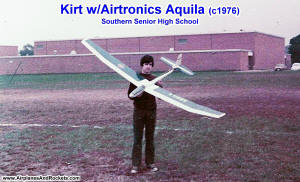 Sailplanes
(or "gliders" for the unrefined) have always been one of my favorite types of model airplanes. Even back when the
only thing I could afford was the Guillows stick and sheet balsa variety at the convenience store, I tended to prefer
the gliders over the wind-up rubber powered models.
My first built-up sailplane was a Sterling Models Schweitzer (I think it was a 1-26 model). I was intrigued by
its huge (at the time) 42" wingspan, and I loved the graceful lines of the Sailplanes
(or "gliders" for the unrefined) have always been one of my favorite types of model airplanes. Even back when the
only thing I could afford was the Guillows stick and sheet balsa variety at the convenience store, I tended to prefer
the gliders over the wind-up rubber powered models.
My first built-up sailplane was a Sterling Models Schweitzer (I think it was a 1-26 model). I was intrigued by
its huge (at the time) 42" wingspan, and I loved the graceful lines of the
 fuselage.
If I recall correctly, it was a real bear to build because of the many tiny balsa part to cut out (I used a single-edged
razor blade in those days - X-acto knives came later). There were what seemed like hundreds of 1/16" square balsa
stringers to install in the wings, tail surfaces and fuselage. Somehow, I managed to get it completed and covered
with Jap tissue. It was very lightweight, and the wings were surprisingly strong for how thin the airfoil was and
how high of an aspect ratio it had. As with most of my other models, I cannot recall what happened to it, other than
ultimately it must have bitten the dirt. fuselage.
If I recall correctly, it was a real bear to build because of the many tiny balsa part to cut out (I used a single-edged
razor blade in those days - X-acto knives came later). There were what seemed like hundreds of 1/16" square balsa
stringers to install in the wings, tail surfaces and fuselage. Somehow, I managed to get it completed and covered
with Jap tissue. It was very lightweight, and the wings were surprisingly strong for how thin the airfoil was and
how high of an aspect ratio it had. As with most of my other models, I cannot recall what happened to it, other than
ultimately it must have bitten the dirt.

| Suppliers |
|
|
Links, Photos & Reviews |
|
|
| Websites |
|
|
My first radio controlled sailplane was a Marks Models Windward that had a 72" wingspan. It was covered with silkspan
and was painted orange and white, with a sunburst on the top of the wings. It flew pretty well, but the kit was very
poorly done. The parts had a lousy fit, and the wing was not very strong. It lasted quite a long while, though. The
radio was an OS Digital 3-channel rig (see picture of main, and a magazine ad for it).
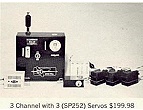 The
servos were fairly small for the day, and were actually the rotational type rather than the linear. The range on the
system was only about 700-800 feet, and the servos jittered to beat all. Even with multiple trips back to the factory,
the performance never got much better. Still, it was better than nothing. The
servos were fairly small for the day, and were actually the rotational type rather than the linear. The range on the
system was only about 700-800 feet, and the servos jittered to beat all. Even with multiple trips back to the factory,
the performance never got much better. Still, it was better than nothing.After graduating from the Windward,
I took on the Marks Models Windfree sailplane that had a 99" wingspan. It was equally difficult to build, but it flew
much better than the Windward. While on a trip to New York to visit relatives in Lackawanna, I looked up in the sky
and what to my wonder eyes should appear, but an RC glider floating around. There was a large schoolyard behind my
uncles property, so I beat feet over there and found a guy with a High Start and a 2-channel Kraft radio where staring
upward. He had that combination receiver + 2 servos unit that Kraft made for a while (the KP2B ???). He put
in some really long flights, so I figured if he could do it, then so could I. Well, I never did get the kind
of durations he did, but made improvements over the Windward times. My Windward was red and white. I have no idea
what happened to it or the Windward, other than they both must have met an unhappy fate.
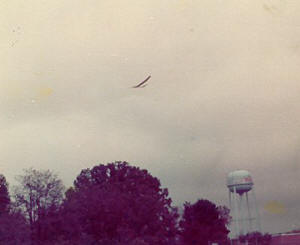 Back
around 1975 or so, RC Modeler magazine ran a feature on a design called the "Aquila." It had incredibly graceful lines
and I knew I just had to build one. Airtronics had not yet produced a kit for it, so I ordered plans and built one
from scratch. There was a hardware and canopy package available, though, so I purchased it. The pictures at the top
of this page are of the Aquila I built off the plans. A radio failure (still that same old 3-channel job) ended its
life. Fortunately, by then the kit was available from Airtronics, and my parents gave me one for Christmas. It was
very well done and the parts all fit very well. The Aquila was not a beginner's project by any means. What I liked
best about the design was the removable, all-flying stabilizer (stabilator). I bought a Cirrus 4-channel radio to
use in it and used the wing spoilers. That brought a whole new dimension into RC sailplane flying. I put so many flights
on it that the fuselage got worn out (OK, so partially due to some hard landings). Some company began offering an
ABS molded fuselage for the Aquila, so I bought one and breathed new life into the plane. The picture to the right
of my barracks Back
around 1975 or so, RC Modeler magazine ran a feature on a design called the "Aquila." It had incredibly graceful lines
and I knew I just had to build one. Airtronics had not yet produced a kit for it, so I ordered plans and built one
from scratch. There was a hardware and canopy package available, though, so I purchased it. The pictures at the top
of this page are of the Aquila I built off the plans. A radio failure (still that same old 3-channel job) ended its
life. Fortunately, by then the kit was available from Airtronics, and my parents gave me one for Christmas. It was
very well done and the parts all fit very well. The Aquila was not a beginner's project by any means. What I liked
best about the design was the removable, all-flying stabilizer (stabilator). I bought a Cirrus 4-channel radio to
use in it and used the wing spoilers. That brought a whole new dimension into RC sailplane flying. I put so many flights
on it that the fuselage got worn out (OK, so partially due to some hard landings). Some company began offering an
ABS molded fuselage for the Aquila, so I bought one and breathed new life into the plane. The picture to the right
of my barracks
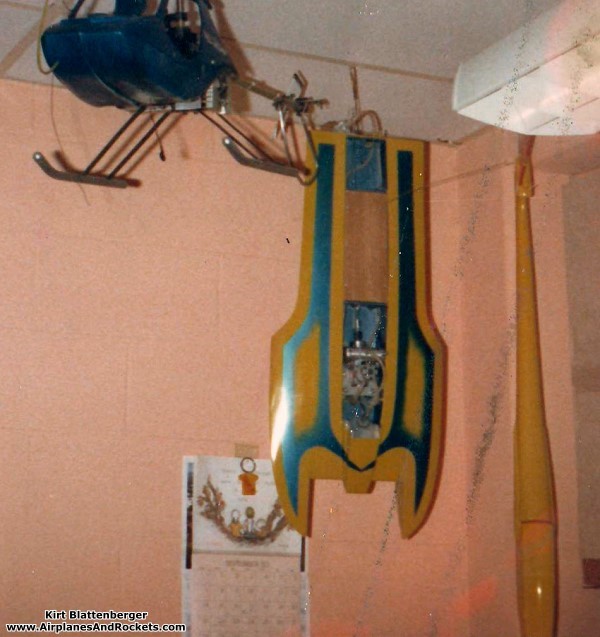 room
at Robins AFB, GA, includes the ABS fuselage. room
at Robins AFB, GA, includes the ABS fuselage.
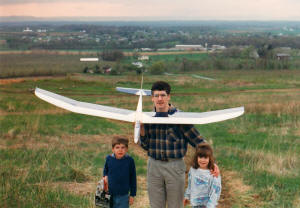 After
getting out of the USAF in 1982, and getting married to Melanie in 1983, the serious hobby endeavors took a hiatus
until my son, Philip, and daughter, Sally, were old enough to be introduced to model aviation. The picture to the
left is from while we were living in Smithsburg, MD, circa 1993. That was the first of many Great Planes 2-meter Spirit
gliders I would build. We were fortunate enough to live in the country and there were flying spots all around. A large
field across the road allowed me to use either a short HiStart (UpStart) or a power pod I built to strap to the top
of the wing. A Cox .049 Black Widow took it up about 500' and the pod + engine + propeller + weight After
getting out of the USAF in 1982, and getting married to Melanie in 1983, the serious hobby endeavors took a hiatus
until my son, Philip, and daughter, Sally, were old enough to be introduced to model aviation. The picture to the
left is from while we were living in Smithsburg, MD, circa 1993. That was the first of many Great Planes 2-meter Spirit
gliders I would build. We were fortunate enough to live in the country and there were flying spots all around. A large
field across the road allowed me to use either a short HiStart (UpStart) or a power pod I built to strap to the top
of the wing. A Cox .049 Black Widow took it up about 500' and the pod + engine + propeller + weight
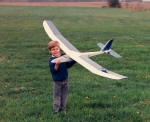 barely
affected the performance at all. It actually helped on windy days. To top off barely
affected the performance at all. It actually helped on windy days. To top off
 the
perfection of my location in Smithsburg, about three miles away was a road named Crystal Falls Drive, and just to
the north of it was an open slope that rose about 100 feet above the farm fields below. That was where my first successful
slope soaring ever took place. I still beat myself up for ever moving from Smithsburg, but, as they says, hind sight
is 20-20. the
perfection of my location in Smithsburg, about three miles away was a road named Crystal Falls Drive, and just to
the north of it was an open slope that rose about 100 feet above the farm fields below. That was where my first successful
slope soaring ever took place. I still beat myself up for ever moving from Smithsburg, but, as they says, hind sight
is 20-20.
  As
an aside, my house also had a clear shot of the High Rock hang glider launching spot (click on thumbnails). It was
a small outcropping from amongst the trees that was 1000' above the ground below. I loved watching the hang gliders
soar up underneath the billowing cumulus clouds and then finally touch down in the field across from our house. As
an aside, my house also had a clear shot of the High Rock hang glider launching spot (click on thumbnails). It was
a small outcropping from amongst the trees that was 1000' above the ground below. I loved watching the hang gliders
soar up underneath the billowing cumulus clouds and then finally touch down in the field across from our house.
 OK,
so time went on and on and on, and finally I built another 2-meter Spirit. This time we (Melanie, Philip and Sally
and me) were living in Colorado Springs, CO. I joined the Pikes Peak
Soaring Society and flew at their fine field a few times before eventually moving to Baldwinsville, NY. Philip
soloed for the first time on this Spirit. He had a bad habit of hitting immovable objects with it (a shed and a goal
post), so it got a little deformed in the leading edge. It repaired rather well, though. I ended up selling it before
moving back to Colorado (NY taxes are awful). OK,
so time went on and on and on, and finally I built another 2-meter Spirit. This time we (Melanie, Philip and Sally
and me) were living in Colorado Springs, CO. I joined the Pikes Peak
Soaring Society and flew at their fine field a few times before eventually moving to Baldwinsville, NY. Philip
soloed for the first time on this Spirit. He had a bad habit of hitting immovable objects with it (a shed and a goal
post), so it got a little deformed in the leading edge. It repaired rather well, though. I ended up selling it before
moving back to Colorado (NY taxes are awful).
 I
decided to try my hand at electric flight and purchased Great Planes Spectra electric powered sailplane while in Loveland,
CO, and was able to fly it from an expansive field adjacent to my back yard. The only obstacles to avoid were the
cow pies. The Spectra is basically a 2-meter Spirit, with a motor and prop up front. I think it was a 400 size. Rather
than use the servo-actuated on-off switch, I used an electronic speed control (ESC). The motor was a real piece of
garbage. After about 4 or 5 motors runs, the brushes began fouling with a hard crust layer after every run. It always
involved disassembling the motor and cleaning the brushes. I got so fed up with it that I just stopped flying it.
We then moved to Kernersville, NC, where we now still live. I dusted off the Spectra I
decided to try my hand at electric flight and purchased Great Planes Spectra electric powered sailplane while in Loveland,
CO, and was able to fly it from an expansive field adjacent to my back yard. The only obstacles to avoid were the
cow pies. The Spectra is basically a 2-meter Spirit, with a motor and prop up front. I think it was a 400 size. Rather
than use the servo-actuated on-off switch, I used an electronic speed control (ESC). The motor was a real piece of
garbage. After about 4 or 5 motors runs, the brushes began fouling with a hard crust layer after every run. It always
involved disassembling the motor and cleaning the brushes. I got so fed up with it that I just stopped flying it.
We then moved to Kernersville, NC, where we now still live. I dusted off the Spectra
 and
flew it a few times at a local elementary school. On one ill-fated flight in the winter, my aging eyes told me the
Spectra was in front of a big oak tree while on a landing approach, when in actuality, the oak was between my Spectra
and me. Needless to say, I was quite shocked when the beast came to a sudden halt and tumbled to the ground. The experience
was rather strange because the tree was far enough away that I saw the plane hit before the noise from the crunching
of the branches reached my ears (my eyesight is terrible, but my hearing is still very good). and
flew it a few times at a local elementary school. On one ill-fated flight in the winter, my aging eyes told me the
Spectra was in front of a big oak tree while on a landing approach, when in actuality, the oak was between my Spectra
and me. Needless to say, I was quite shocked when the beast came to a sudden halt and tumbled to the ground. The experience
was rather strange because the tree was far enough away that I saw the plane hit before the noise from the crunching
of the branches reached my ears (my eyesight is terrible, but my hearing is still very good).
  A
couple years later (this past winter), I built yet another 2-meter Spirit sailplane. A modification I made to the
Spectra, I also made to this Spirit. It involves replacing the rear part of the canopy that overhangs the leading
edge of the wing with a built-up fairing. That canopy overhang is easily damaged. Rather than allow the canopy to
extend beyond the rear canopy frame and over the top of the wing, the canopy is trimmed flush with the frame, and
a balsa fairing is built onto the wing. A
couple years later (this past winter), I built yet another 2-meter Spirit sailplane. A modification I made to the
Spectra, I also made to this Spirit. It involves replacing the rear part of the canopy that overhangs the leading
edge of the wing with a built-up fairing. That canopy overhang is easily damaged. Rather than allow the canopy to
extend beyond the rear canopy frame and over the top of the wing, the canopy is trimmed flush with the frame, and
a balsa fairing is built onto the wing.
 This
provides what I consider to be a nicer looking interface, and it exposes the canopy to less of a threat of damage.
A bulkhead is cut and shaped to match the rear of the canopy, minus 1/16" for sheeting, then a single spine is cut
to put in the middle that conforms to the airfoil shape and provides a natural extension from the canopy shape. Finally,
two pieces of 1/16" balsa are glued in place, the gaps filled, and sanded to a final shape. The picture to the right
shows the finished product. This
provides what I consider to be a nicer looking interface, and it exposes the canopy to less of a threat of damage.
A bulkhead is cut and shaped to match the rear of the canopy, minus 1/16" for sheeting, then a single spine is cut
to put in the middle that conforms to the airfoil shape and provides a natural extension from the canopy shape. Finally,
two pieces of 1/16" balsa are glued in place, the gaps filled, and sanded to a final shape. The picture to the right
shows the finished product.
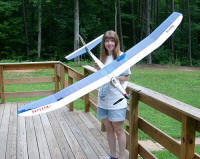 Believe
it or not, finding an open field around here in NC large enough to stretch out a HiStart is difficult. Privately owned
fields are usually off limits any more because of liability issues (smack a lawyer the next time you see one and thank
him). After having my launch line land in a tree, I decided to convert the Spirit to electric. An order was placed
with Tower Hobbies (they have been the recipients of about 80% of my hobby money in the last 2 decades) for a Great
Planes Triton charger, two 1500 mAh Li-Poly battery packs, and a Master Airscrew 400 brushed motor w/3:1 gearbox and
10x8 folding propeller. The motor/gearbox was much too large and pretty heavy. Dang. Believe
it or not, finding an open field around here in NC large enough to stretch out a HiStart is difficult. Privately owned
fields are usually off limits any more because of liability issues (smack a lawyer the next time you see one and thank
him). After having my launch line land in a tree, I decided to convert the Spirit to electric. An order was placed
with Tower Hobbies (they have been the recipients of about 80% of my hobby money in the last 2 decades) for a Great
Planes Triton charger, two 1500 mAh Li-Poly battery packs, and a Master Airscrew 400 brushed motor w/3:1 gearbox and
10x8 folding propeller. The motor/gearbox was much too large and pretty heavy. Dang.
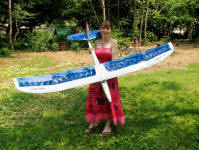 I
wanted to get a good brushless motor, but from what I could see, the cheapest models Tower had started at around $120,
and the special ESCs were about $80. Yesterday, Melanie and I went to KayCee Hobbies in High Point, NC, and with the
help of a knowledgeable fellow named Robert, we left with an Elite Park 400 Outrunner motor ($55) and an Elite 20-Amp
Brushless Speed Control ($42). I think the prices were excellent. I am utterly amazed at how much power is packed
into that small motor. Modifications have begun for the installation of the motor. I plan to use a couple degrees
of right thrust and down thrust as a starting point. I don't recall what the Spectra used for thrust offset, but it
did pretty well with the factory amounts. I
wanted to get a good brushless motor, but from what I could see, the cheapest models Tower had started at around $120,
and the special ESCs were about $80. Yesterday, Melanie and I went to KayCee Hobbies in High Point, NC, and with the
help of a knowledgeable fellow named Robert, we left with an Elite Park 400 Outrunner motor ($55) and an Elite 20-Amp
Brushless Speed Control ($42). I think the prices were excellent. I am utterly amazed at how much power is packed
into that small motor. Modifications have begun for the installation of the motor. I plan to use a couple degrees
of right thrust and down thrust as a starting point. I don't recall what the Spectra used for thrust offset, but it
did pretty well with the factory amounts. Final ready-to-fly weight ended up at 32.6 ounces, compared to 31.5
ounces for the original configuration.

Motor & Firewall |

Motor on Firewall |

Firewall in Fuselage |

Motor in Fuselage |

Firewall in Fuselage |

Motor, Battery & ESC |

Fuselage Cooling Holes |
|

Receiver & Servos |

Modified Canopy |

Modified Canopy |
|
 View the video of its maiden flight as the e-Spirit, July 16, 2005.
View the video of its maiden flight as the e-Spirit, July 16, 2005.
We have been having a lot of wet and windy weather here in my area, but I couldn't wait any longer. Yesterday
(7-16-2005), I took the e-Spirit out and I gave it a 12 minute and 20 second flight in very strong winds. Under power
it just about hovered over the same spot as I climbed in to the wind. Overcast conditions meant no thermals to seek
out, but I just wanted to make sure the darn thing would work - and work it did! with the 1500 mAh Li-Poly battery,
Elite Park 400 Outrunner brushless motor & ESC, and 10x8 folding prop, it climbed at about a 45 degree angle all
the way until almost out of sight. After floating down and fighting the wind, I was able to make three more climbs
to about 500 feet after getting down to about 20 feet AGL. This is definitely a good setup - it weighs only 1.1 ounces
more than the original sailplane-only configuration. |